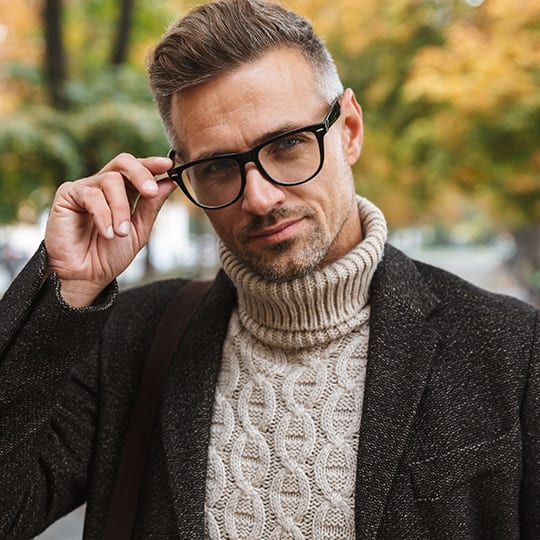Preserving Your Visual Health
Eye disease can be challenging to manage, but at Lake Country Optometry, we can help. Conditions like glaucoma, cataracts, diabetic eye disease, and age-related macular degeneration (AMD) all have one thing in common—the need for early detection and management to help protect your vision.
We use diagnostic technology during eye exams, including OCT and visual field testing, for a complete picture of your eye health.
We can diagnose and co-manage various eye diseases to support your long-term eye health. Contact us to schedule your appointment today.
Request AppointmentEarly Detection & Management
We want to help you manage eye disease as soon as possible, and that starts with regular exams. Using current technology, we can get a detailed look at your eye health and detect issues and signs of potential problems.
Regular eye exams are important and allow our team to detect possible issues early to get a head start on finding solutions.
Our Diagnostic Technology
Preparation and expertise are a big part of what we do at Lake Country Optometry. When it comes to eye disease diagnosis and management, early detection is essential for protecting and preserving your long-term vision. Our technology plays a big role in our eye disease management services.
We include ultra-widefield digital imaging for all eye exams and visual field testing and corneal pachymetry for monitoring glaucoma.
The Different Forms of Eye Disease
Eye disease can be difficult to navigate, and a big part of that is likely because there are so many different kinds. We strive to help you understand the various eye diseases and early signs and symptoms so you can better know when to visit us.
We offer glaucoma testing and management and cataract surgery co-management as a part of our eye disease services.
Glaucoma Testing & Management
Our glaucoma management services begin with diagnostic testing and a comprehensive eye exam.
You may work closely with Dr. Alim Karmali, who completed a residency in ocular disease with a focus on glaucoma management. We may even refer you to a specialized professional for complex glaucoma care, such as surgical treatments.
Glaucoma is not a singular disease. It’s a group of eye diseases that damage the optic nerve, where increased pressure inside the eye, or intraocular pressure (IOP), is a common risk factor.Age, family medical history, and previous eye injuries can all be contributing risk factors for glaucoma, and maintaining a regular eye exam schedule to monitor your vision is essential, especially if you are at risk for developing glaucoma.
Cataract Surgery Co-Management
Our cataract co-management services include pre-op evaluations and post-op care. Our evaluations include retinal imaging for diagnostics, and we can refer you to a surgeon for surgery.
Cataracts develop when the clear lens of the eye becomes clouded. They can cause symptoms like blurry vision, dim or yellowed vision, and difficulty seeing at night.If cataracts progress and prevent you from going about your daily activities, such as reading or driving, cataract surgery may be recommended.
Diabetic Eye Disease
Our diabetic eye disease evaluations employ optical coherence tomography (OCT) to monitor how diabetes affects your vision.
Diabetes is a condition that makes regulating blood sugar levels difficult. It can also affect your vision and increase your risk of developing eye diseases like glaucoma, cataracts, and diabetic retinopathy, which can be a significant vision loss concern.
Some signs and symptoms of diabetic retinopathy include blurry vision, a loss of central vision, and difficulty seeing at night.
Age-Related Macular Degeneration
AMD is a progressive disease that damages the macula, leading to central vision loss. This damage can make activities like reading and driving much more difficult. AMD is a leading cause of vision loss among older adults. It has 2 primary types:
-
- Dry AMD is the more common form of the disease and occurs in early, intermediate, and late stages. It occurs when the macula thins with age.
-
- Wet AMD is less common and can cause faster and more severe vision loss. Wet AMD occurs when abnormal blood vessels grow in the back of the eye and damage the macula.
We can diagnose and monitor age-related macular degeneration (AMD) with a thorough dilated exam, optomap imaging, and OCT scans . Consistent eye exams, adjusting your diet, and giving up smoking can be effective prevention methods for AMD.
Prioritizing Your Long-Term Eye Health
Maintaining your eye health is an ongoing partnership. Our team at Lake Country Optometry is always open to answering your questions or concerns. Any information you give us can be crucial for monitoring, diagnosing, and treating potential vision problems.
We aim to preserve your long-term visual health—contact us to schedule your appointment today.
Request AppointmentOur Location
Visit Us
Find us on the corner of Main Street and Beaver Lake Road. We are accepting new patients and looking forward to welcoming you and your family.
Our Address
- 49-9522 Main Street
- Lake Country, BC V4V 2L9
Contact Information
- Phone: 250-766-4240
- Fax: 250-766-4267
- Email: [email protected]
Our Hours
- Monday: 9:00 AM – 5:00 PM
- Tuesday: 9:00 AM – 5:00 PM
- Wednesday: 8:00 AM – 7:00 PM
- Thursday: 9:00 AM – 5:00 PM
- Friday: 9:00 AM – 5:00 PM
- Saturday: 9:00 AM – 3:30 PM
- Sunday: Closed
Our Brands





Frequently Asked Questions
Can you make glasses with an external prescription?
Yes, we accept all prescriptions for glasses that have not expired. If your prescription is expired or you need to have your prescription assessed, we are more than happy to book you an appointment with one of our doctors for an exam.
How long does it take for glasses to arrive?
We make glasses in-house, and it takes around 3 hours for us to edge the lenses into your frame of choice. If glasses need to be ordered in, they typically take around 7 to 10 business days. Specialty orders may take longer to arrive. Our optical will do our best to give you an accurate time estimate and have your glasses made as soon as we can.
What is included in a full eye exam?
A full eye exam includes the following:
-
- A comprehensive ocular and medical history check-up to identify or assess your risk factors for certain eye diseases
-
- A vision check and prescription for glasses, if warranted
-
- Binocular vision testing to check how your eyes are functioning together
-
- A measurement of intraocular pressure (IOP) on all patients
-
- An optomap scan of your retina on all patients
-
- An OCT (optical coherence tomography) scan for adults
-
- A comprehensive eye health check in the office by the doctor
-
- If warranted, your eye doctor may recommend a visual field test to better assess peripheral vision in association with the use of medications with risk of harmful effects on vision
What is the cost of an eye exam?
Children (18 and under), seniors (65+), or those with certain medical conditions are eligible for medical services plan (MSP) coverage. MSP covers part of the eye exam and visual field tests (think of it like insurance), lowering the total cost of the exam you/your insurance is responsible for. We do not charge for children age 2 and under.
A patient is NOT eligible for MSP coverage if:
- You are from out of province
- Not registered with BC medical
- If you have had an eye exam elsewhere within the past year
| Service | Full Cost | If MSP Billable |
| Adult Eye Exam (19+) | $152 | $105 |
| Adult Contact Lens Wearer Eye Exam (19+) | $167 | $120 |
| Child Eye Exam (2-18) | $85 | $30 |
| Child Contact Lens Wearer Eye Exam (2-18) | $100 | $45 |
Do you do LASIK co-management?
Yes, we are more than happy to be a part of your LASIK journey. We are pleased to offer post-op follow-ups.
Can you direct bill my insurance?
Yes, we can directly bill most insurance companies. If your insurance company is not eligible for direct billing, we will provide you with a detailed receipt to submit for reimbursement.
What do I need to bring to my eye exam?
Please bring a list of medications, your glasses and contact lenses (or your last prescription), and any forms that need to be completed.
How long is an eye exam?
Full eye exams are usually between 30 to 45 minutes.
Do I have to be dilated during the exam?
Our office offers wide-field retinal imaging with the optomap machine on all patients who are physically able to. The optomap scan provides a 200-degree image of the retina (inside lining of the eye).
In certain cases, dilation is still recommended to better assess the retina and check for cataracts and other ocular diseases. If you are dilated, we encourage bringing a driver with you so you feel more safe on the way home.






